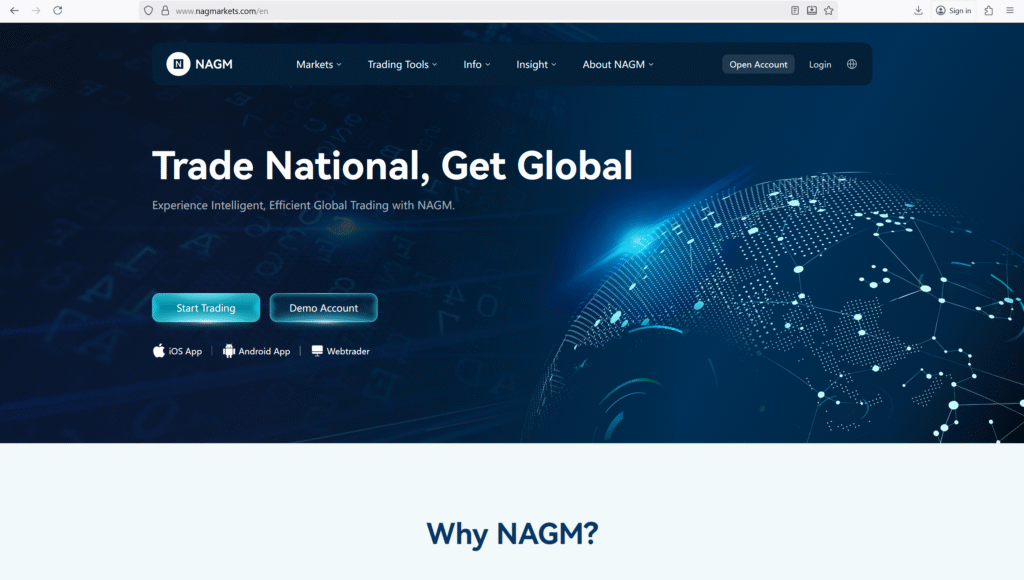
If you’re looking at NAG Markets as a possible platform for trading forex or CFDs, you must tread carefully. What you see may look appealing—sleek site, big promises, modern trading platforms—but beneath the surface lie multiple red flags signalling serious risk. Here are ten powerful warning signs that you should thoroughly evaluate before depositing any funds.
1. Offshore Regulation & Weak Oversight
NAG Markets claims regulation under Vanuatu Financial Services Commission (VFSC) and the Seychelles Financial Services Authority (FSA). While technically regulated, these are offshore jurisdictions commonly associated with less stringent investor protections compared to major regulators like the UK’s FCA or Australia’s ASIC. That means your funds may have weaker legal safeguards.
2. Short Operating History & Emerging Brand
Analyses indicate NAG Markets was launched in or around 2020-2021. A newer broker doesn’t automatically mean scam, but it does mean you have less track record to evaluate. When combined with high risk products and marketing hype, that’s a dangerous combo.
3. High Minimum Deposit and Promises of Low Spreads
According to users, the minimum deposit at NAG Markets is around USD 500, and it advertises starting spreads from around “1.2 pips”. Those figures aren’t outrageous—but in the context of offshore regulation, they still demand you proceed with caution.
4. Client Complaints: Slippage & Withdrawal Hurdles
There are repeated reports of excessive slippage, entries/exits differing from expected prices, and problems with withdrawals or deposit methods. One user reported entering at XAU/USD 1728.5 and being filled at 1728.55 repeatedly. These irregularities raise questions about trade execution fairness.
5. Media & Review Sites Flag the Risk
Major broker review sites such as BrokersView explicitly state that NAG Markets “may pose a higher level of risk” due to the lack of robust regulation. When independent analysts put your chosen broker into a “higher risk” category, that’s your cue to slow down and dig deeper.
6. Transparency & Ownership Are Limited
While NAG Markets provides a contact address in Sydney (Unit 803, 213 Miller Street North Sydney NSW 2060, Australia) in some listings, the regulatory licences are offshore. ) That mismatch between marketing address vs. regulatory jurisdiction introduces a transparency gap—you may not know exactly who controls your funds.
7. Marketing Appeal vs. Real Investor Safety
NAG Markets offers leverage up to 1:400 (in some listings) and access to MT4/MT5 platforms. These features attract ambitious traders. Yet high leverage amplifies risk and requires strong protections—which offshore regulation may not fully ensure. So you’re in a high-risk game, not a safe environment.
8. Traffic & Review Volume Suggest Limited User Base
One review site indicates that NAG Markets’ website has very low traffic: estimates show ~195 organic monthly visits. A small user base means fewer public testimonials, less peer review, and potentially less accountability. That makes your risk harder to assess.
9. Mixed Reviews: Some Positive, Some Concerning
Some users report good trading conditions, while others raise alarms. For example, one review said spreads and commissions were reasonable; another complained about odd slippage and execution problems This mix means the platform may function sometimes, but inconsistently—and inconsistency in brokers is a red flag.
10. Your Risk Is Higher Than Usual
Putting all of the above together—offshore regulation, early stage brand, inconsistent feedback, trading anomalies—you face a higher-than-normal risk if you choose NAG Markets. It doesn’t mean it’s definitely a scam, but you must treat it as high-risk speculation, not as a safe or regulated alternative.
EXCLUSIVE CONCLUSION
Here’s the blunt truth: NAG Markets presents as a modern, flashy trading broker with decent features—but underneath, the structural holes are significant enough that you need to massively amplify your caution before proceeding.
First, the regulatory framework. Yes, NAG Markets claims licences from VFSC and Seychelles FSA—but that’s offshore. That means your protections in event of insolvency, fraud or dispute are much weaker versus a broker under FCA, ASIC or similar. This regulatory gap alone should make you pause.
Second, you’re dealing with less history, fewer public reviews, and limited transparency. A broker that is relatively new inherently has fewer proven outcomes. That means less evidence of consistent withdrawals, fewer reliability signals, and less public accountability. That’s a risk you absorb.
Third, the user feedback is a mixed bag—with concerning issues around slippage and withdrawals. Users reporting they got filled at worse prices, or had slow or problematic deposit/withdrawal experience—is significant. In trading, execution fairness and fund access are not optional—they are foundational. If you’re seeing problems there, you’re risking your money under sub-optimal conditions.
Fourth, marketing leverage and asset access are strong points, but they also raise the stakes. High leverage (1:400) means even small market moves can wipe your account fast. If you don’t have excellent risk management and protections, you could be hurt badly. And since the platform is offshore‐reg, that risk is amplified.
Fifth, the small traffic and limited independent reviews suggest you’re navigating in relatively thin waters. Fewer users means less collective knowledge, fewer complaints published, less scrutiny. That makes your personal due diligence all the more essential—but also means you have less safety net built in.
So what should you do if you’re seriously considering NAG Markets despite these red flags? Proceed with the following mindset: treat your deposit as money you may lose. Start with the minimum, test withdrawals early, document everything, and ensure you understand the terms. Do not deposit significant capital until you’ve seen that withdrawals work, customer service responds, servers run smoothly, and execution fairness is verified.
In contrast, if you’re looking for a brokerage environment with fewer risks and stronger built-in protections, you might opt for a firm regulated by top-tier authorities, with many years of public operation, large user base, and documented case history of fund protections and payouts.


